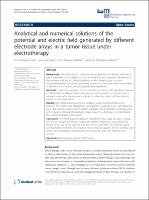Please use this identifier to cite or link to this item:
https://repositorio.usj.es/handle/123456789/284
| Title: | Analytical and numerical solutions of thepotential and electric field generated by differentelectrode arrays in a tumor tissue underelectrotherapy |
| Authors: | Pupo, Ana Elisa Bergues



Reyes, Juan Bory 


Cabrales, Luis Enrique Bergues 

Bergues Cabrales, Jesús Manuel 
|
| Keywords: | Electroterapia; Tumor; Campo eléctrico |
| Issue Date: | 2011 |
| Publisher: | Springer |
| Citation: | Pupo, A. E. B., Reyes, J. B., Cabrales, L. E. B., & Cabrales, J. M. B. (2015). Analytical and numerical solutions of the potential and electric field generated by different electrode arrays in a tumor tissue under electrotherapy. Paper presented at the IFMBE Proceedings, , 49 871-875. doi:10.1007/978-3-319-13117-7_221 |
| Description: | Background:Electrotherapy is a relatively well established and efficient method oftumor treatment. In this paper we focus on analytical and numerical calculations ofthe potential and electric field distributions inside a tumor tissue in a two-dimensional model (2D-model) generated by means of electrode arrays with shapesof different conic sections (ellipse, parabola and hyperbola).Methods:Analytical calculations of the potential and electric field distributions basedon 2D-models for different electrode arrays are performed by solving the Laplaceequation, meanwhile the numerical solution is solved by means of finite elementmethod in two dimensions.Results:Both analytical and numerical solutions reveal significant differencesbetween the electric field distributions generated by electrode arrays with shapes ofcircle and different conic sections (elliptic, parabolic and hyperbolic). Electrode arrayswith circular, elliptical and hyperbolic shapes have the advantage of concentratingthe electric field lines in the tumor.Conclusion:The mathematical approach presented in this study provides a usefultool for the design of electrode arrays with different shapes of conic sections bymeans of the use of the unifying principle. At the same time, we verify the goodcorrespondence between the analytical and numerical solutions for the potential andelectric field distributions generated by the electrode array with different conicsections. |
| URI: | https://repositorio.usj.es/handle/123456789/284 |
| ISSN: | 16800737 |
| Appears in Collections: | Artículos de revistas |
Files in This Item:
| File | Description | Size | Format | |
|---|---|---|---|---|
| Analytical and numerical solutions of the.pdf | 929,27 kB | Adobe PDF |  View/Open |
This item is licensed under a Creative Commons License

